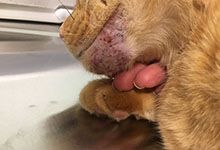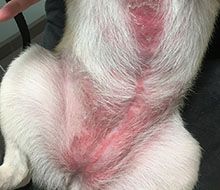Identifying food allergies: The veterinary elimination diet trial
There is only one way to truly determine whether the clinical signs youre seeing in your patient are reactions to a food ingredient or additive. Heres how to conduct a proper elimination diet trial.
The term cutaneous adverse food reaction (food allergy) is often used to define the food-triggered clinical syndrome of allergic dermatitis, gastrointestinal (GI) signs or both. Food allergies may be responsible for chronic skin and ear disease in both cats and dogs.
Potential allergens can include protein sources (e.g. chicken, turkey, beef, lamb, soy, dairy, eggs) or carbohydrate sources (e.g. corn, rice, barley, wheat). Some pets can have more than one food allergy. Food allergies often start in pets younger than 1 or older than 7 years of age, but they can be acquired at any time, even when a pet has been eating the same food for months to years.
What does food allergy look like?
Food-allergic animals usually have nonseasonal pruritus because the source of the problem does not change with the weather or seasons. About 20% of food-allergic pets also have GI signs such as flatulence, vomiting, diarrhea, loud intestinal sounds, or defecating more than four to five times a day. Dogs may scratch their face, ears, feet, groin or anal area or develop recurrent skin or ear infections (Figure 1). A frequent presentation includes licking at the anal area in addition to problems with the ears-this is why the condition is often referred to as one that affects “ears and rears.” Cats may overgroom certain areas of the body or the whole body, exhibit intense itching at the face or neck, or develop ear infections.


Figure 1. Skin infections in a food-allergic cat (top) and dog (bottom). Images courtesy of Judy Seltzer, BVetMed, MRCVS, DACVDThe onset of food allergy can be slow and gradual or more sudden. Clinical signs often continue to progress as long as the offending allergen is fed. It can take several weeks to months for clinical signs to resolve once the allergenic agent is removed from the animal's diet. Up to 30% of food-allergic pets may have other allergies, such as a flea allergy dermatitis or atopy (environmental allergies). About 50% of food-allergic dogs will not respond favorably to steroids.
Diagnosis and treatment of food allergy
The only accurate way to diagnose an animal with a food allergy is to remove all of the currently fed foods and start a strict elimination diet trial. Available blood and saliva tests are not reliable for diagnosing food allergies in cats and dogs, and skin testing has also been found to be ineffective.
An elimination diet consists of a prescribed home-cooked or prescription therapeutic diet that contains a unique protein and carbohydrate source to which the animal has not previously been exposed. The most common novel protein diets include rabbit and potato, venison and potato, and kangaroo and oats. Many fish and lamb diets are no longer considered novel as these ingredients are more commonly used in over-the-counter (OTC) diets.
Another option is to use a hydrolyzed (low-molecular-weight) diet, also available by prescription. These diets are composed of common ingredients (such as chicken and soy) that have been molecularly altered to be below the allergenic threshold. This alteration prevents the animal's immune system from recognizing the food.
Oh, no, you didn't
Simply changing from one brand of pet food to another does not constitute an allergy diet trial. Several OTC “allergy” or “limited-ingredient” diets are now available in pet stores and online, but they are not always as pure as they claim to be or may have hidden ingredients.
Some pets with food allergies will not get better on a pet store diet. A small percentage of truly food-allergic animals remain undiagnosed with commercially prepared diets and need to be trialed with a home-cooked diet.
Home-cooked diets. Examples of proteins used in home-cooked diets are tilapia, salmon, duck, rabbit, pork or pinto beans, usually mixed with sweet potatoes, oats, quinoa or barley. A home-cooked diet should be nutritionally balanced. Therefore, recommend that the client consult with a board-certified nutritionist before feeding a home-cooked diet. Nutritionists are also extremely helpful when an animal has a concurrent disease, such as urinary tract infection, history of bladder stones or irritable bowel disease, and they can work with the primary veterinarian or dermatologist to formulate an appropriate diet. Websites including balanceit.com and raynenutrition.com have also been helpful in formulating home-cooked diets for a trial.
Therapeutic diets. Veterinary dermatologists often prescribe therapeutic diets from Royal Canin, Hill's and Purina for use in elimination trials. In addition, Rayne Clinical Nutrition makes rabbit, kangaroo and pork diets for dogs and cats that are less processed than dry kibble or canned foods. Selecting a diet will depend on your patient's diet history. Furthermore, some cats and dogs will require a wet food to help administer medications, and some owners are adamant about having treats to feed their pet. Knowing the needs of your patient and client will help in choosing the most appropriate diet for your patient.
Did we mention elimination diet trials are strict?
Emphasizing to clients that absolutely no other food products or treats should be given during an elimination diet trial is imperative. The pet should be allowed to consume only the prescribed diet, associated treats and water. Pets in an elimination trial cannot have:
Table food
Rawhides, pig ears, bones or other chew toys made with animal products
Supplemental fatty acids
Parasite preventives, medications or toothpastes with added flavor
Treats used to administer medications (e.g. peanut butter, cream cheese, lunch meat, pill pockets).
Regardless of which elimination diet is selected, it should be introduced gradually over a five- to seven-day period. This is extremely important as some animals may develop GI problems if their diet is changed suddenly. Most pets adapt to the new diet well, but some need time to adjust. If the pet doesn't adjust to the new diet within a week or two or refuses multiple therapeutic diets, a home-cooked diet can be formulated with the help of a veterinary nutritionist. To formulate the best possible plan for your patient, it is also important to take into consideration challenges such as households with multiple pets or small children.
The elimination trial should continue for at least eight to 12 weeks and a minimum of one month beyond resolution of a skin infection. The pet should be rechecked frequently to assess the progress and results of the diet trial. Rechecks may be more frequent if the pet is being treated for an active infection.
If the pet has a food allergy, we expect to see at least a 50% reduction in licking, scratching, chewing or other dermatologic signs. This may occur within the first four weeks for some animals; in others the response may take up to 12 weeks. Cats may need to be on the elimination diet for three to four months before a food allergy is confirmed.
The diet challenge
To prove that a food allergy is responsible for a pet's condition, a diet challenge is typically performed. This involves reintroducing the original diet, or ingredients from the original diet, to see if the pet has any reaction. In the food-allergic pet, clinical signs will usually worsen within hours to two weeks. If an adverse reaction occurs, resume the elimination diet exclusively. Once the flare-up is resolved, reintroduce individual ingredients from the former diet one at a time to identify the specific cause.
Beyond proving the food allergy diagnosis accurate, a food challenge helps to determine which specific foods or treats should be avoided and to identify an OTC diet that the pet can tolerate. If we can determine the ingredient causing the problem, we can manage the condition by eliminating the offending food(s) from the pet's diet for life.
Keep in mind, however, that this may not always be possible. Some patients may need to remain on a therapeutic or home-cooked diet for life. Feeding a therapeutic diet long-term will not harm a pet because these diets are well balanced. Therapeutic diets tend to be more expensive than OTC diets, however, and many owners prefer to feed a commercial diet.
Prognosis
As with other types of allergies, there is no cure for food allergy. What's more, animals can develop new food allergies over time. However, if a food allergy is the sole cause of a pet's skin or ear problems, identifying and eliminating the protein(s) or carbohydrate(s) causing the allergy may significantly increase the pet's quality of life and reduce or prevent skin and ear problems in the future.
As noted earlier, pets with an allergy to food ingredients are at higher risk for developing other allergies such as atopic dermatitis or flea allergy dermatitis. To keep below an animal's itch threshold, all food-allergic pets should be maintained with strict flea control and monitored for secondary skin infections and itching.
Dr. Judy Seltzer graduated from the Royal Veterinary College in London and completed her residency in dermatology at the University of Florida. She has been working in her home state of New York since 2009, currently at BluePearl Veterinary Partners in New York City. She and her husband have a little girl and four cats and enjoy traveling, fall festivals, winter activities and dining out.